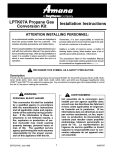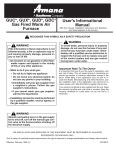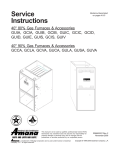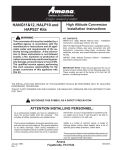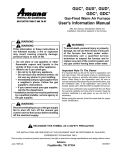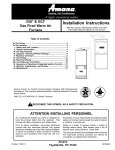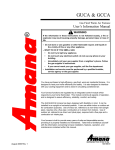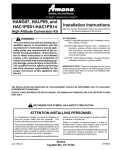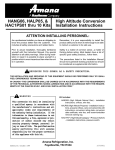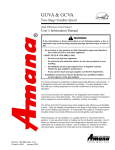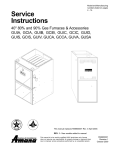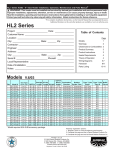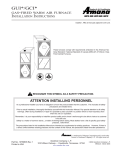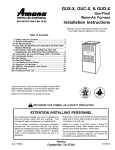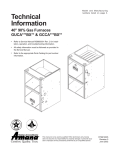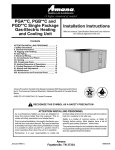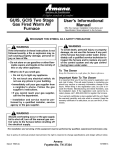Download Amana PGD**C Instruction manual
Transcript
LPTK09 Heating & Air Conditioning ® Propane Gas Conversion Kit Com fort. Q uality. Trust. Installation Instructions DE SIG N CE R TI FI E D C E RT I F I E D Description This kit converts Amana gas-fired units from natural to propane gas. The conversion from natural gas (as shipped from the factory) to propane gas requires: - Replacing burner orifices - Replacing pilot orifice (Package Gas-Electric Units only) - Replacing gas valve regulator spring (all single stage units) - Removing NOx screens/turbulators (screens/turbulators not used on all units) - Applying conversion identification labels Any conversion to propane gas is the responsibility of, and at the risk of, the person making the conversion. This kit applies only to the following: Product Models Non-Condensing Gas Furnaces GUIA, GUIB, GUIC, GUID, GCIA, GCIB, GCIC, GUIS, GCIS, GUIV Condensing Gas Furnaces GUC, GUD, GUX, GCD, GDC, GUCA, GCCA, GUVA Package Gas-Electric Units PGA**C, PGB**C, PGD**C This kit includes: Installation Instructions Propane gas burner orifice (#55) Propane gas pilot orifice (BBR12 for Package Gas-Electric units equipped with pilot Honeywell system) Gas Valve Conversion kits (with instructions) Conversion rating plate Conversion date certificate Screen/Turbulator removal warning tag Wire ties RECOGNIZE THIS SYMBOL AS A SAFETY PRECAUTION. ATTENTION INSTALLING PERSONNEL As a professional installer you have an obligation to know the product better than the customer. This includes all safety precautions and related items. Prior to actual installation, thoroughly familiarize yourself with this Instruction Manual. Pay special attention to all safety warnings. Often during installation or repair it is possible to place yourself in a position which is more hazardous than when the unit is in operation. June 2001 (1) Rev. 3 Remember, it is your responsibility to install the product safely and to know it well enough to be able to instruct a customer in its safe use. Safety is a matter of common sense...a matter of thinking before acting. Most dealers have a list of specific good safety practices...follow them. The precautions listed in this Installation Manual are intended as supplemental to existing practices. However, if there is a direct conflict between existing practices and the content of this manual, the precautions listed here take precedence. Amana 1810 Wilson Parkway • Fayetteville, TN 37334 10308713 Contents General Information ....................................................................................................................... 3 Orifice Conversion ......................................................................................................................... 4 Non-Condensing Furnaces ..................................................................................................................... 4 Manifold/Valve Removal .................................................................................................................................... 4 Burner Orifice Replacement ............................................................................................................................. 4 Condensing Furnaces ............................................................................................................................. 4 Manifold/Valve Removal .................................................................................................................................... 4 GUD/GCD Furnaces........................................................................................................................ 4 All Other Condensing Furnaces ....................................................................................................... 4 Burner Orifice Replacement ............................................................................................................................. 4 Package Gas-Electric ............................................................................................................................. 4 Manifold/Valve Removal .................................................................................................................................... 4 Package Gas-Electric Units With Pilot ............................................................................................ 4 Package Gas-Electric Units Without Pilot ....................................................................................... 4 Burner Orifice Replacement ............................................................................................................................. 4 All Package Gas-Electric Units ....................................................................................................... 4 Pilot Orifice Replacement ................................................................................................................................. 5 Package Gas-Electric Units Equipped With Pilot ............................................................................ 5 Gas Valve Regulator Spring Replacement ................................................................................... 6 Single Stage Units Only .................................................................................................................................... 6 NOx Screen Removal ..................................................................................................................... 7 Non-Condensing Furnaces and Package Gas-Electric .................................................................................. 7 Manifold Reinstallation ................................................................................................................. 8 Condensing & Non-Condensing Furnaces ............................................................................................. 8 Package Gas-Electric ............................................................................................................................. 8 Package Gas-Electric Units Equipped With Pilot ............................................................................ 8 Package Gas-Electric Units Without Pilot ....................................................................................... 8 Adjustments, Checks, and Tests ................................................................................................... 9 Orifice and Igniter Check ........................................................................................................................ 9 Line Pressure Check ............................................................................................................................... 9 All Units .............................................................................................................................................................. 9 Manifold Pressure Check ........................................................................................................................ 9 Single Stage Units (GUIA/B/C/D, GCIA/B/C, GCD, GDC GUC/D/X, GCC, GUCA, GCCA, PGA/B/D**C) ........ 9 Two-Stage Units (GUIS/V, GCIS, GUVA) ........................................................................................................... 9 Unit Operation Check and Labelling ..................................................................................................... 10 Verify Gas Input Rate(s) .................................................................................................................................. 10 Check Normal Operating Sequence of Ignition System ............................................................................... 10 Inspect Burner Flame ...................................................................................................................................... 10 Check and Adjust Unit Temperature rise ....................................................................................................... 10 Label Attachment ............................................................................................................................................ 10 Setting GUD/GCD Manifold Pressure ......................................................................................... 12 2 General Information WARNING PERSONAL INJURY HAZARD This conversion kit must be installed by a qualified agency in accordance with the manufacturer’s instructions and all applicable codes and requirements of the authority having jurisdiction. If the information in these instructions is not followed exactly, a fire, explosion or production of carbon monoxide can result causing property damage, personal injury or loss of life. The qualified service agency performing this work assumes responsibility for the proper conversion of this appliance with this kit. WARNING PERSONAL INJURY HAZARD To prevent death, personal injury, or property damage due to fire or explosion from a propane gas leak, install a gas detecting warning device. A gas detecting warning device is the only reliable way to detect a propane gas leak. Do not rely on smell as rust can reduce the level of odorant in propane gas. Remember: • Propane gas is heavier than air and leaking gas can settle in any low area or confined space. • A propane gas odor can fade, making the gas undetectable. • A warning device is a required item, if the propane gas unit is installed in either a basement, an excavated area or a confined space. If the presence of gas is suspected: • Do not try to light any appliance. • Do not touch any electrical switch or use any phone in your building. • Immediately call your gas supplier from a neighbor’s phone. Follow the gas supplier’s instructions. • If you cannot reach your gas supplier, call the fire department. Contact a local propane gas supplier about installing a gas detecting warning device. IN CANADA “THE CONVERSION SHALL BE CARRIED OUT IN ACCORDANCE WITH THE REQUIREMENTS OF THE PROVINCIAL AUTHORITIES HAVING JURISDICTION AND IN ACCORDANCE WITH THE REQUIREMENTS OF THE CAN/CSA B149.1 AND B149.2 INSTALLATION CODE.” Due to policy of continual product improvement, the right is reserved to change specifications and design without notice. 3 Orifice Conversion The gas manifold along with the gas valve must be removed in order to access the burner orifices. Before proceeding, shut off gas supply at manual shutoff and turn off power to unit. 5. Remove the screws securing the manifold and valve to the burner bracket. Separate gas manifold and valve from burner bracket. ALL OTHER CONDENSING FURNACES 1. Disconnect wiring from the gas valve. 2. Where necessary, cut wire ties securing wiring to manifold. CAUTION 3. Remove the screws securing the manifold and valve to the burner bracket . Separate gas manifold and valve from burner bracket . PERSONAL INJURY HAZARD The gas supply must be shut off prior to disconnecting the electrical power, before proceeding with the conversion. BURNER ORIFICE REPLACEMENT 1. Remove natural gas orifices from gas manifold using a box end wrench. 2. Install propane gas orifices. Tighten orifices with a box-end wrench; do not use a socket wrench as it could damage the orifices; do not cross-thread or overtighten. Refer to table 1 for the appropriate LP kit and orifice size. Non-Condensing Furnaces MANIFOLD/VALVE REMOVAL Package Gas-Electric 1. Disconnect wiring from the gas valve. 2. Remove burner box door. MANIFOLD/VALVE REMOVAL PACKAGE GAS-ELECTRIC UNITS WITH PILOT NOTE: GUID furnaces do not have a burner box door. 1. Disconnect wiring from the gas valve. 3. Where necessary, cut wire ties securing wiring to manifold. 2. Where necessary, cut wire ties securing wiring to manifold. 4. Remove the screws securing the manifold and valve to the burner box bracket. Separate gas manifold and valve from burner box. 3. Remove the screws securing the pilot assembly to the burner tray. 4. Remove the pilot assembly, pilot tubing, gas manifold and valve together. CAUTION: Pilot tube is delicate do not bend or crimp. BURNER ORIFICE REPLACEMENT 1. Remove natural gas orifices from gas manifold using a box end wrench. PACKAGE GAS-ELECTRIC UNITS WITHOUT PILOT 2. Install propane gas orifices. Tighten orifices with a box-end wrench; do not use a socket wrench as it could damage the orifices; do not cross-thread or overtighten. Refer to Table 1 for the appropriate LP kit and orifice size. 1. Disconnect wiring from the gas valve. 2. Where necessary, cut wire ties securing wiring to manifold. 3. Remove the screws securing the manifold and valve to the burner box or burner bracket. Separate gas manifold and valve from burner box or burner bracket. Condensing Furnaces BURNER ORIFICE REPLACEMENT ALL PACKAGE GAS-ELECTRIC UNITS MANIFOLD/VALVE REMOVAL GUD/GCD FURNACES 1. Remove natural gas orifices from gas manifold using a box end wrench. 1. Disconnect wiring from the gas valve. 2. Install propane gas orifices. Tighten orifices with a box-end wrench; do not use a socket wrench as it could damage the orifices; do not cross-thread or overtighten. Refer to table 1 for the appropriate LP kit and orifice size. 2. Remove burner box door. 3. Disconnect burner box hose from gas valve. 4. Where necessary, cut wire ties securing wiring to manifold. 4 Orifice Conversion 2. Replace with propane gas pilot orifice provided and reconnect wiring. Use care, do not damage igniter. Package Gas-Electric Cont’d PILOT ORIFICE REPLACEMENT PACKAGE GAS-ELECTRIC UNITS EQUIPPED WITH PILOT The pilot orifice must be replaced on Packaged Gas-Electric Units equipped with a Honeywell “Smartvalve” and pilot ignition system. Pilot Orifice Figure 1 Package Unit Pilot Orifice 1. Disconnect pilot assembly wiring from gas valve and remove natural gas pilot orifice from the pilot assembly. Propane Gas Orifices Product Type Non-Condensing Gas Furnaces Condensing Gas Furnaces Package Gas-Electric Units Standard Altitude Model Kit Number Altitude (ft) GUIA,GUIB, GCIA, GCIB LPTK09 0 - 7500 #55 GUIC, GCIC, GUID LPTK09 0 - 6000 GUIS, GCIS, GUIV LPTK09 GUC, GUD, GUX, GDC, GCD, GCC High Altitude Burner Pilot Orifice Orifice Kit Number Altitude (ft) Burner Orifice Pilot Orifice N/A HALP09 7501 - 11000 #56 N/A #55 N/A HALP09 6001 - 11000 #56 N/A 0 - 7000 #55 N/A HALP09 7001 - 8500 #56 N/A LPTK09 0 - 4500 #55 N/A HALP09 4501 - 9500 #56 N/A GUCA, GCCA LPTK09 0 - 7000 #55 N/A HALP10 7001 - 11000 #56 N/A N/A HALP11 7001 - 11000 #56 N/A BBR12 HALP09 6001 - 9500 #56 BBR12 6001 - 9500 #56 N/A GUVA LPTK09 0 - 7000 #55 PGA**C***D PGB**C***D PGD**C***D LPTK09 0 - 6000 #55 PGA**C***E PGB**C***E PGD**C***E LPTK09 0 - 6000 #55 Table 1 5 N/A HALP09 Gas Valve Regulator Spring Replacement SINGLE STAGE UNITS ONLY The gas valve regulator spring must be replaced on all single stage gas furnaces and packaged gas/electric units. Replace the gas valve regulator spring with the propane gas regulator spring from the proper spring kit. Follow the manufacturer’s instructions provided in the spring kit. Discard all unused spring kits. Two-stage units do not require a spring change. CAUTION Spring kits are not interchangeable. A White-Rodgers gas valve requires a White-Rodgers spring kit; a Honeywell gas valve requires a Honeywell spring kit, etc. Refer to Figures 2 through 8 for gas valve identification. Mates With Honeywell Q3450* Pilot Harness ON OFF OFF Inlet Pressure Tap Gas Control/Valve Knob Gas Valve On/Off Control Knob Figure 2 Honeywell Model VR-8205 OUTLET INLET Pilot Tube Connection Outlet Pressure Tap IN IN INLET ON OUTLET ON IGNITOR PSI INLET 2 1 /2PS I Inlet Pressure Tap OFF Outlet (Manifold) Pressure Tap Honeywell Pressure Regulator Adjustment (Under Cap Screws) OUTLET CONTROL Pressure Regulator Adjustment (Under Cap Screw) Mates With HONEYWELL Q3450* Pilot Harness Pressure Regulator Adjustment (Under Cap Screw) Pilot Tube Connection Mates With Socket Housing Control Module Outlet Pressure Tap 1/8 N.P.T., Plugged (Steel) Figure 4 Honeywell Model SV9501 Figure 3 Honeywell Model SV9500 High Manifold Regulator Adjustment Screw (Under Cap) Gas Valve On/Off Control Knob Gas Valve On/Off Selector Switch PM C HI INLET OUTLET Inlet Outlet O F F INLET M 1 P 3 C 2 ON OUTLET OFF ON Inlet Pressure Tap (Side of Valve) Pressure Regulator Adjustment (Under Cap Screw) Outlet (Manifold) Pressure Tap Inlet Pressure Tap Outlet (Manifold) Low Manifold (Side of Valve) Pressure Tap Regulator Adjustment Gas Valve (Side of Valve) Screw (Under Cap) Control Knob Figure 5 White-Rodgers Model 36E36 or 36E37 Gas Valve On/Off Control Lever In ON Position Figure 6 White-Rodgers Model 36E96 or 36E54 Outlet (Manifold) Pressure Tap (Side of Valve) Inlet Pressure Tap (Side of Valve) Gas Valve On/Off Selector Switch OUTLET OUTLET Inlet Pressure Tap (Side of Valve) Inlet Pressure Tap (Side of Valve) Pressure Regulator Adjustment (Under Cap Screw) Pressure Regulator Adjustment (Under Cap Screw) Outlet (Manifold) Pressure Tap Figure 9 White-Rodgers Model 36F22 Figure 8 Robertshaw Model 7222 6 Outlet (Manifold) Pressure Tap (Side of Valve) Figure 7 White-Rodgers Model 36E22 or 36E23 INLET INLET Pressure Regulator Adjustment (Under Cap Screw) NOx Screen Removal WARNING PERSONAL INJURY HAZARD All metal screens must be removed from the heat exchanger tubes when using propane gas. Failure to comply could cause serious personal injury or death. Failure to comply with this requirement will also void warranty coverage. NOTE: To prevent premature heat exchanger failure, follow the instructions below to remove all metal screen inserts from the entrance of heat exchanger tubes during propane conversions. Not all models will have metal screen inserts. NON-CONDENSING FURNACES AND PACKAGE GAS-ELECTRIC PARTITION PANEL 1. Remove the screws securing the burner box to the partition panel. Separate burner box from unit RETENTION PLATE 2. Remove the screw(s) securing the NOx screen retention plate and remove the plate. 3. Remove and discard NOx screens. 4. Reinstall the NOx screen retention plate and burner box. BURNER BOX ASSY. SCREENS Figure 10 Typical NOx Screen Removal 7 Manifold Reinstallation Condensing & Non-Condensing Furnaces CAUTION 1. Reinstall gas manifold and valve. Pilot assembly must be properly aligned with burners for proper ignition. Refer to Figure 11. 2. Reconnect wiring (and burner box hose on GUD and GCD furnaces) to gas valve. Secure wiring to manifold using wire ties provided. Ensure wiring does not interfere with orifices or burners. Package Gas-Electric PACKAGE GAS-ELECTRIC UNITS EQUIPPED WITH PILOT CORRECT POSITION 1. Reinstall gas manifold and valve. 2. Secure the pilot assembly to the burner tray. 3. Reconnect wiring to gas valve. Secure wiring to manifold using wire ties provided. Ensure wiring does not interfere with orifices or burners. PACKAGE GAS-ELECTRIC UNITS WITHOUT PILOT 1. Reinstall gas manifold and valve. 2. Reconnect wiring to gas valve. Secure wiring to manifold using wire ties provided. Ensure wiring does not interfere with orifices or burners. "A" DIMENSION "A" CANNOT EXCEED 1/4" Figure 11 Pilot Assembly Positioning 8 Adjustments, Checks, and Tests The following adjustments and checks are a required part of this conversion. Adjustments and checks include: • Leak checking orifices • Verifying proper igniter positioning • Checking line and adjusting manifold gas pressures • Verifying proper unit operation (input rate, operational sequence, burner flame, temperature rise, etc.) Manifold Pressure Check Orifice and Igniter Check SINGLE STAGE UNITS (GUIA/B/C/D, GCIA/B/C, GCD, GDC GUC/D/X, GCC, GUCA, GCCA, PGA/B/D**C) ADJUST GAS MANIFOLD PRESSURE WARNING PERSONAL INJURY HAZARD Set the manifold pressure. The pressure must be between 9.7 and 10.3 inches W.C. For setting direct vent (GUD, GCD) furnace manifold pressure, see “Setting GUD and GCD Manifold Pressure” section at the end of this manual. To prevent death, personal injury or property damage due to fire or explosion, do not use a flame to check for leaks. 1. Turn OFF gas to the unit at the manual gas shutoff valve. 1. Leak check burner orifice threads using a soap solution. 2. Connect a calibrated water manometer or appropriate gas pressure gauge at the gas valve outlet pressure tap. 2. Visually inspect the igniter for damage. Replace if damaged. Package Gas Electric Units 3. Turn ON gas supply and operate unit. Verify that the pilot assembly is in the proper place. 4. Remove the cover over the manifold pressure regulator adjustment screw. 3. Reinstall the burner box door (where applicable). 5. Adjust manifold pressure: Turn adjustment screw out (counterclockwise) to decrease pressure. Turn in (clockwise) to increase pressure. Line Pressure Check ALL UNITS CHECK LINE PRESSURE SUPPLIED TO TWO-STAGE UNITS (GUIS/V, GCIS, GUVA) ADJUST GAS MANIFOLD PRESSURE GAS VALVE 1. Turn OFF the power and gas at the manual gas shutoff valve. 1. Turn OFF gas to the unit at the manual gas shutoff valve. 2. Connect a calibrated water manometer or appropriate gas pressure gauge to the “inlet pressure tap” of the gas valve or “gas piping drip leg”. 2. Connect a calibrated water manometer or appropriate gas pressure gauge at the gas valve outlet pressure tap. 3. Turn ON the power and gas, put the unit into heating cycle and turn on all other gas consuming appliances. 3. Turn ON gas supply and operate unit. 4. Remove the cap screw from the low stage manifold pressure regulator. 4. Measure the gas supply pressure with the burners firing. The inlet gas pressure must be between 11.0 and 13.0 inches W.C. If supply pressure differs from required, make necessary adjustments to pressure regulator(s), gas piping, etc. 5. Using an Allen wrench, increase low stage manifold pressure by adjusting the low stage manifold regulator so the furnace will light and carry over. 6. Remove the cap screw from the high stage manifold pressure regulator adjustment location. 5. Turn OFF gas to the unit at the manual shutoff valve and disconnect manometer. Turn OFF any unnecessary appliances started in step 3. 7. Using an Allen wrench, adjust high stage manifold regulator to the required manifold pressure (Table 2). 8. Reinstall the high stage manifold regulator cap screw. Confirm high stage manifold pressure. 9 Adjustments, Checks, and Tests Manifold Pressure Adjustment Cont’d Unit Operation Check and Labelling VERIFY GAS INPUT RATE(S) 9. Using an Allen wrench, adjust low stage manifold regulator to the required pressure (Table 2). Ensure that the appropriate orifices have been installed and the manifold pressure has been set as stated in these instructions. 10. Reinstall the low stage manifold regulator cap screw. Confirm low stage manifold pressure. 11. Turn OFF gas supply to unit, and disconnect manometer. CHECK NORMAL OPERATING SEQUENCE SYSTEM Manifold Pressure for Propane Gas Two-Stage Units Low Stage High Stage OF IGNITION Check the normal operating sequence of the ignition system to ensure burners light properly. 5.7 to 6.3" W.C. INSPECT BURNER FLAME The burner flames should be stable, soft and blue (dust may cause orange tips but they must not be yellow). They should extend directly outward from the burners without curling, floating, or lifting off. 9.7 to 10.3" W.C. Table 2 CHECK AND ADJUST UNIT TEMPERATURE RISE Check and adjust unit temperature rise(s) as described in the installation manual. Temperature rise must be within the range shown on the furnace rating plate. LABEL ATTACHMENT Attach the label (found in the spring kit), indicating propane gas conversion, to the gas valve. Attach conversion data plate, with correct input rating, adjacent to the unit rating plate. Use Tables 3 or 4 to determine the correct data plate to be applied. Post “conversion date certificate” adjacent to the unit rating plate. 10 Adjustments, Checks, and Tests Single Stage Units Input Ratings (Standard Altitude) Size Model Two Stage Units Input Ratings (Standard Altitude) Propane Input (BTU/hr) Size GUIA, GUIB, GUIC, GCIA, GCIB, GCIC, GUID, 045 GCD, GDC, GUCA, GCCA, 41,400 PGB**C, PGD**C GUC, GUD, GUX, GCC 40,500 GCD, GDC, GUCA, GCCA, 62,100 PGA**C, PGB**C, PGD**C GUC, GUD, GUX, GCC 63,000 GUIA, GUIB, GUIC, GCIA, GCIB, GCIC, GUID, 090 GCD, GDC, GUCA, GCCA, 82,800 PGA**C, PGB**C, PGD**C GUC, GUD, GUX, GCC 81,000 GUIA, GUIB, GUIC, GCIA, GCIB, GCIC, GUID, 115 GCD, GDC, GUC, GUD, GUX, GCC, GUCA, GCCA, 103,500 PGA**C, PGB**C, PGD**C 140 GUIA, GUIB, GUIC, GCIA, GCIB, GCIC, High Stage Input (BTU/hr) Low Stage Input (BTU/hr) 045 GUVA 41,400 32,000 070 GUIS,GCIS, GUIV, GUVA 62,100 48,000 090 GUIS, GCIS, GUIV, GUVA 82,800 64,000 115 GUIS, GUIV,GUVA 103,500 80,000 140 GUIS, GUIV 124,200 96,000 Table 4 GUIA, GUIB, GUIC, GCIA, GCIB, GCIC, GUID, 070 Model 124,200 PGB**C, PGD**C Table 3 11 Setting GUD/GCD Manifold Pressure Only small variations in gas flow should be made when adjusting the gas valve pressure regulator. For propane gas, the manifold pressure must 9.7 to 10.3” W.C. WARNING To prevent death or personal injury due to carbon monoxide, all hoses must be connected as shown in Figure 12. Failure to connect the hose between the pressure switch and the burner box could result in excessive generation of carbon monoxide. GAS VALVE A C BURNER BOX B TO BURNER BOX TO VENT BLOWER TO VENT BLOWER TO BURNER BOX TRIDELTA TRIDELTA PRESSURE SWITCH (METAL & PLASTIC BODY) (ROTATED 90 FOR CLARITY) (ALL METAL BODY) D VENT BLOWER TO VENT BLOWER TO BURNER BOX U-TUBE MANOMETER A - CAP OVER ADJUSTMENT SCREW MUST BE IN PLACE WHEN FURNACE IS OPERATING. B - SEE PRESSURE SWITCH DIAGRAM FOR PRESSURE SWITCH HOSE CONNECTIONS. MPL PRESSURE SWITCH DIAGRAM TO MEASURE MANIFOLD PRESSURE CONNECT MANOMETER BETWEEN C AND D. C - HOSE BETWEEN GAS VALVE AND AIR BOX (TEE TO BE SUPPLIED BY SERVICER.) D - TAPPED OPENING IN MANIFOLD (HOSE BARB TO BE SUPPLIED BY SERVICER.) 10291404 Figure 12 GUD, GCD Manifold Pressure Measurement 1. Turn OFF gas to the unit at the manual gas shutoff valve. 2. Connect a calibrate “U” tube manometer (or appropriate gas pressure gauge) between the tapped outlet in the gas manifold and a tee (field-supplied) in the hose from the burner box to the gas valve. 3. Turn ON gas supply and operate unit. NOTE: Burner box cover must be in place. 4. Remove the cover over the manifold pressure regulator screw. 5. Adjust manifold pressure. Turn adjustment screw out (counterclockwise) to decrease pressure. Turn adjustment screw in (clockwise) to increase pressure. 6. Reinstall the cover over the manifold pressure regulator adjustment screw in order to check manifold pressure. Make further adjustments if necessary. 7. Turn OFF gas supply to unit and disconnect manometer. 8. Go to “Unit Operation Check and Labelling” section. 12












